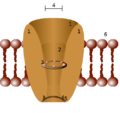Ion channel facts for kids
An ion channel is like a tiny door or tunnel in the outer skin of a cell. These special doors are made of proteins. They help control the tiny electrical power (called voltage) that exists across the cell's skin, also known as the plasma membrane. They do this by letting tiny charged particles called ions flow in and out of the cell. This flow of ions is super important for how cells work!
Contents
What are Ion Channels?
Ion channels are special proteins that create a small opening, or "pore," through the cell membrane. Think of the cell membrane as the cell's outer wall. These channels are found in the membranes of all living cells. They are essential for many cell activities.
Most ion channels are made up of several protein parts that fit together. They form a complete structure that can open and close. This allows them to control what goes in and out.
How Do Ion Channels Work?
Cells have a small electrical difference, or voltage, across their outer membrane. This is like a tiny battery. Ion channels help to create and control this voltage. They do this by letting ions move across the membrane.
Ions are atoms or molecules that have an electrical charge. When ion channels open, they allow specific ions to rush in or out of the cell. This movement of charged particles changes the electrical voltage across the membrane. It's like turning a switch on or off for the cell's electricity.
Why Are Ion Channels Important?
Ion channels are vital for almost every process in your body. They are especially important in your brain and nervous system.
For example, when you think, move, or feel something, your nerve cells (neurons) use ion channels. These channels open and close very quickly. This creates electrical signals that travel along the nerves. These signals allow your brain to communicate with the rest of your body.
Ion channels are also important for:
- Your heart beating regularly.
- Your muscles contracting so you can move.
- Your senses, like sight, hearing, and touch.
- Your kidneys working to filter blood.
If ion channels don't work correctly, it can lead to many health problems.
Who Discovered Ion Channels?
The amazing discovery of how ion channels work was recognized with a very important award. In 2003, the Nobel Prize in Chemistry was given to two scientists. They were Peter Agre and Roderick MacKinnon.
Peter Agre discovered water channels, which are similar to ion channels. Roderick MacKinnon figured out the exact structure of ion channels. He showed how they can let only certain ions pass through. Their discoveries helped us understand how cells communicate and function.
Images for kids
-
Schematic diagram of an ion channel. 1 - channel domains (typically four per channel), 2 - outer vestibule, 3 - selectivity filter, 4 - diameter of selectivity filter, 5 - phosphorylation site, 6 - cell membrane.
-
Birth of an Idea (2007) by Julian Voss-Andreae. The sculpture was commissioned by Roderick MacKinnon based on the molecule's atomic coordinates that were determined by MacKinnon's group in 2001.
See also
 In Spanish: Canal iónico para niños
In Spanish: Canal iónico para niños




